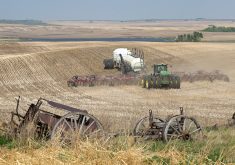The Saskatchewan Party government focused on keeping promises and planning for growth as it announced its first budget March 19.
The government plans spending $8.57 billion on revenue of $9.37 billion. It put $250 million on the provincial debt and will keep $1.3 billion in its growth and financial security fund – a rainy day fund it once criticized – to help balance future budgets.
“We’ve got to be able to have a bit of a shock absorber there,” said premier Brad Wall, referring to the fund. “The question is whether we need to use the fund.”
Read Also

Senft to step down as CEO of Seeds Canada
Barry Senft, the founding CEO of the five-year-old Seeds Canada organization is stepping down as of January 2026.
He said paying down debt is also important but not at the cost of an increasing infrastructure deficit.
The centrepiece of the budget was the $1 billion infrastructure program called Ready for Growth.
Former finance minister Harry Van Mulligen said the budget was similar to previous NDP budgets, noting that imitation is the sincerest form of flattery.
“In fact, I would go so far as to categorize this as an NDP-almost budget,” he said. “It almost addresses all the needs of the people of the province.”
But he singled out education tax on property as one area where the budget didn’t go far enough.
The first phase of the government’s commitment to reduce the tax will see the average agricultural landowner save about $477 over last year, for a total of $2,072 as the rebate climbs to 47 percent from 38.
Urban homeowners, however, will see only $27 in savings. Total property tax relief is $156.6 million.
“This is a government that is sitting on $1.3 billion,” Van Mulligen said.
Finance minister Rod Gantefoer said the government kept 40 of its campaign promises. The education tax platform included incremental increases to the rebate while a long-term solution for funding kindergarten to Grade 12 is sought.
“Saskatchewan people are seeing real benefits in this budget,” he said.
Highlights include $3.75 billion in health-care spending, which represents 43.7 percent of the total operating expenses, and $1.95 billion for education, or 22.7 percent of spending.
The province continued a tuition freeze, and added money for graduate retention programs, nurse recruitment and retention, nursing training seats and physician recruitment.
It added 500 new child-care spaces and increased wages for child-care workers by four percent.
It also implemented the Saskatchewan Infrastructure Growth Initiative, which will make available $75 million in interest-free loans to municipalities to help them build or repair infrastructure.
Government debt by March 31, 2009, is forecast to be $6.7 billion. Total debt, including crown corporations, is projected at $10.5 billion a year from now.

















